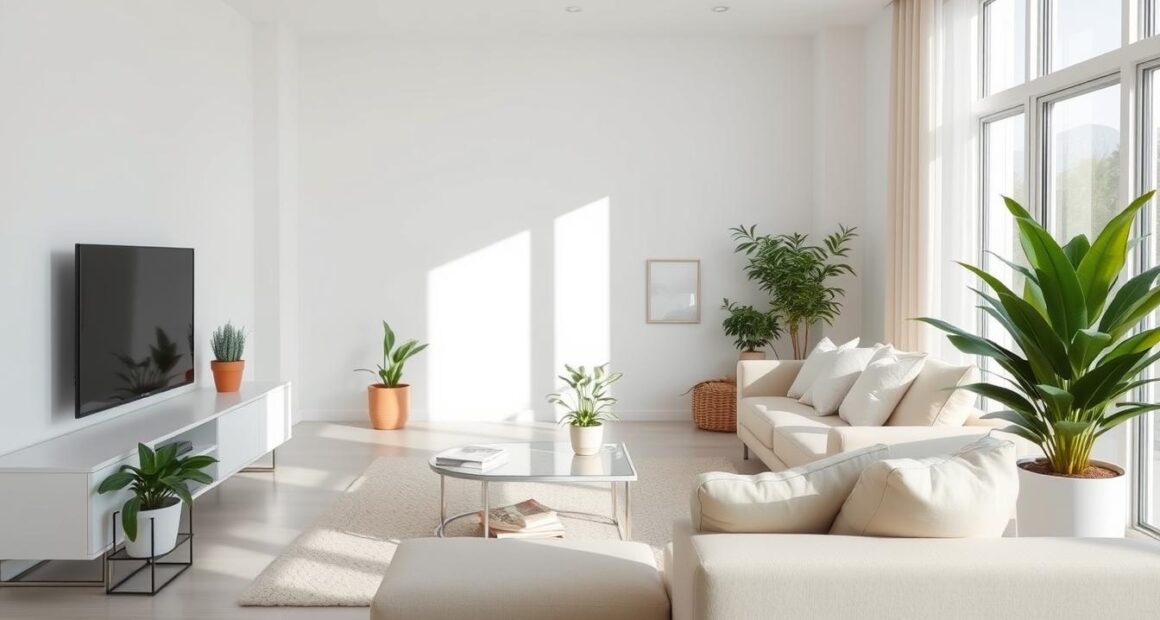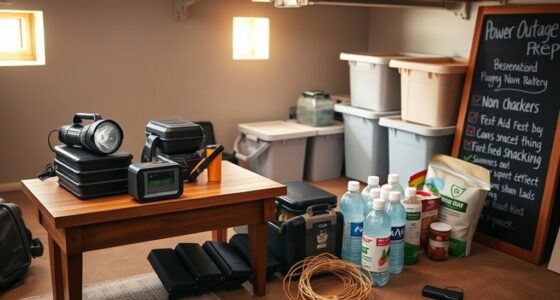Have you ever come home feeling tired, only to find a mess waiting? You’re not alone. A huge 85% of people feel more anxious in cluttered spaces. Clutter affects our mood and health. By decluttering, you bring peace and freedom into your life. Imagine a room where everything is in its place and calm rules. It’s time for you to create a peaceful space at home. Let’s look at how to declutter. We’ll find ways to keep your home organized and peaceful.
Key Takeaways
- 59% of American households live paycheck to paycheck, often feeling the burden of clutter.
- Giving away one item daily can lead to removing 365 items from your home each year.
- The 12-12-12 challenge helps manage clutter by addressing 36 items at a time.
- Just 15 minutes a day can significantly alleviate the feelings of overwhelm caused by clutter.
- Homes with less clutter contribute to improved mental health outcomes, with 60% reporting better conditions.
Understanding the Emotional Impact of Clutter
Clutter does more than fill up your space. It really affects how you feel inside. Having too much stuff can make you feel anxious and upset. It can also make you feel overwhelmed and tired. By understanding how clutter affects your feelings, you can start to clean up your space and feel better.
Clutter as a Visual Reminder
Every item you see around you reminds you of things you haven’t done. These reminders are everywhere, making it hard to relax. They can make you feel guilty and ashamed. This can increase your anxiety and make clutter worse.
Studies show a typical room has over 2,000 items. This can be too much for your brain and hurt your mental health. Clutter can make your body respond like you’re stressed, with signs like high cortisol levels.
How Clutter Affects Your Mental State
Clutter and how you feel are closely linked. Feeling down or anxious can lead to more clutter. This turns into a hard cycle to break. Studies show cluttered spaces can make you 30% less productive. This is because of too much information for your brain.
Too much stuff can lead to putting things off. This isn’t just about daily chores. It can make you less happy with your life overall. About 70% of people feel guilty and ashamed because of their clutter. It’s important to seek help to deal with these feelings.
| Clutter Factor | Emotional Consequences |
|---|---|
| Visible clutter | Increased anxiety and irritability |
| Unfinished tasks | Feelings of guilt and shame |
| Cognitive overload | Reduced decision-making ability |
| Procrastination | Decreased life satisfaction |
| Emotional attachment to items | Heightened stress levels |
By seeing how everything is connected, you can figure out why clutter happens. This can help you take steps to a cleaner, happier space.
The Benefits of Decluttering Your Space
Creating a clutter-free area improves your well-being. As you declutter, you will see many benefits of decluttering that change your life.
Less Stress and More Calm
Clutter can make you feel stressed. About 70% of people in messy homes feel more stressed. A clean space gives order, reducing stress and bringing calm.
You feel more in control, which is good for your mental health. Around 60% say decluttering makes them mentally healthier.
Improved Focus and Productivity
A decluttered place helps you focus and relax your mind. Studies show less clutter means up to 50% less mental clutter. Keeping things organized can make you 20% more productive.
About 70% believe a tidy space helps them think better, boosting productivity. Decluttering does more than just make your space look good. It boosts your mental state, focus, and efficiency.
| Benefits | Impact (%) |
|---|---|
| Stress Reduction | 70% |
| Less Cognitive Overload | 50% |
| Increased Focus | 70% |
| Productivity Boost | 20% |
| Improved Mental Health | 60% |
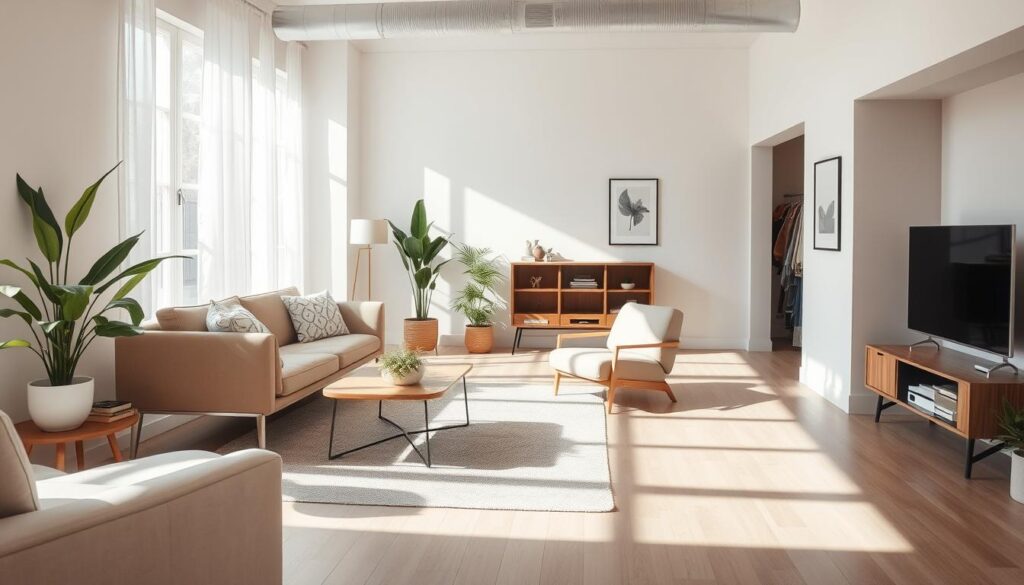
Where to Start: Overcoming Overwhelm
Feeling swamped with clutter can seem huge, but start small. You don’t need to clear a whole room right away. Pick easy spots to start. This makes the task less scary.
Choosing Your Starting Point
Pick where to start by thinking about what area feels too cluttered. Try starting with something simple like a messy drawer or a corner of your closet. Starting small can help you avoid feeling too stressed and lets you see your progress.
- Try the 90/90 Rule: If you haven’t used an item in 90 days and don’t see a use for it in the next 90 days, consider letting it go.
- The 20/20/20 Rule suggests if an item can be replaced for less than $20 and you can source it within 20 minutes or 20 miles, it’s okay to discard it.
- Limit your decluttering sessions to 20 minutes to keep focus and manage feelings of overwhelm effectively.
The Importance of Small Wins
Small victories are key to staying motivated. Finishing minor tasks gives you a sense of achievement and helps you prepare for bigger ones. A good decluttering plan includes daily efforts, like spending 15 minutes each evening to clear up small messes. Being consistent brings big rewards over time.

| Tip | Description |
|---|---|
| Daily Decluttering | Engage in short nightly sessions to keep clutter at bay. |
| Purge Frequency | Conduct seasonal purges to maintain your organized space. |
| Bye-Bye Bin | Create a designated bin for items to donate or discard. |
| Community Support | Invite friends or family to join in for motivation. |
| Professional Help | Consider consulting a professional organizer for tailored advice. |
By choosing these easy methods, you make decluttering manageable. It leads to instant changes and turns the process fun instead of overwhelming.
Best Way to Declutter: The 4-Box Method
Decluttering can seem daunting when you look at all you’ve gathered over time. The 4-box method makes it simpler and organized. It divides items into four groups, making it easier to decide and less stressful.
Understanding the Categories
The 4-box method sorts things into four areas: KEEP, GIVE AWAY, TRASH, and RELOCATE. Each has a specific role:
- KEEP: Items you regularly use and need.
- GIVE AWAY: Good condition items that others can use.
- TRASH: Things that are broken or can’t be used and need to be thrown away.
- RELOCATE: Seasonal or not currently used items that can be stored elsewhere.
Implementing the Method Effectively
Start by clearly labeling each box. This helps avoid indecision and delays. Set aside 6-8 hours to sort out one room. It feels more doable and less overwhelming this way.
Focusing on one area at a time cuts down the overwhelm by half. The aim is to make choices that lead to a neater space and better mental health.
Use these tips for effective decluttering:
- Start small: Focus on one room or area to avoid getting tired.
- Be decisive: Don’t keep things “just in case.” It only adds to the clutter.
- Use a ‘maybe’ box wisely: It can help hold onto fewer unnecessary items.
- Make it routine: Regularly set times for decluttering to keep things tidy.

Using the 4-box method helps organize your decluttering work. It gives a clear way to handle your items. This approach makes your living space calmer and more enjoyable.
Dealing with Sentimental Items
Sentimental items pose a unique challenge when decluttering. You may feel a strong emotional connection to these things. Deciding what to keep and what to let go of requires careful thought. This balance is crucial for managing your emotions and practical needs.
Letting Go of Memories
About 80% of people find it hard to part with sentimental items. These items remind us of past times. A study says that 70% of people feel stressed by clutter, including sentimental clutter. Letting go can be hard, but it helps us emotionally. It offers a chance to feel free.
Getting rid of sentimental items doesn’t mean you forget the memories. Instead, it helps in cherishing them in new ways. Sharing stories about these items can make it easier to give them away. This process is both freeing and healing.
Finding Balance: Keep vs. Toss
Finding the right balance between keeping and letting go of items is key. Telling stories about these items helps in letting some of them go. Research shows that this makes people more open to parting with items. Try the “Giant Leap” for quick decluttering, or “Baby Steps” for slow progress.
Clear rules help sort through sentimental items. This makes decluttering manageable. Remember, keeping everything is not necessary to honor your memories.
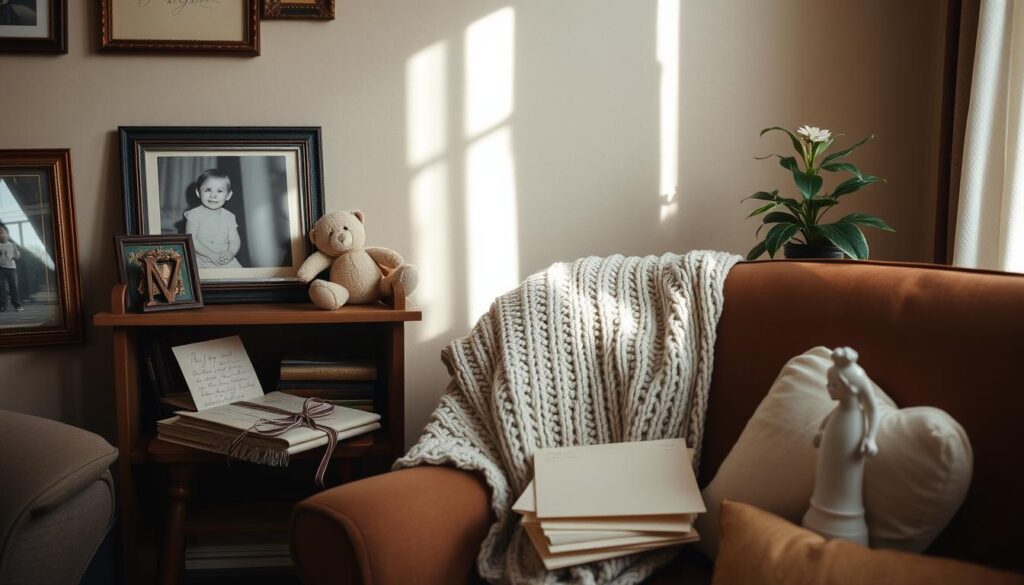
Organizing Your Closet: The One-Year Rule
The one-year rule is a big help in organizing your closet. This rule makes you check if you’ve worn something in the last year. By doing this, you can make your wardrobe fit your current taste better. It helps identify important pieces, letting you keep a collection that truly matches who you are now.
Identifying What to Keep
Look at each piece of clothing you own. If you haven’t worn it for over nine months, think about letting it go. We often keep clothes we don’t wear because of emotional reasons. This can make our closets messy and choosing what to wear hard. It’s key to clean out our closets often. After all, many of us keep things we don’t need, which makes picking an outfit stressful.
- Ask yourself the following questions for each piece:
- Have I worn this in the past year?
- Does this fit my current style?
- How do I feel when I wear this?
Finding Your Personal Style
When tidying up your closet, aim to find the key pieces that speak to you. A neat closet helps you choose outfits easier and lowers stress. You might find that having fewer items, like a 33-piece capsule wardrobe, is refreshing. Changing your clothes with the seasons can keep your style up to date.
Think about organizing your closet by color or type. Having a special place for different clothes makes everything easy to see and keeps your closet tidy. A neat closet makes picking your daily outfit more satisfying.
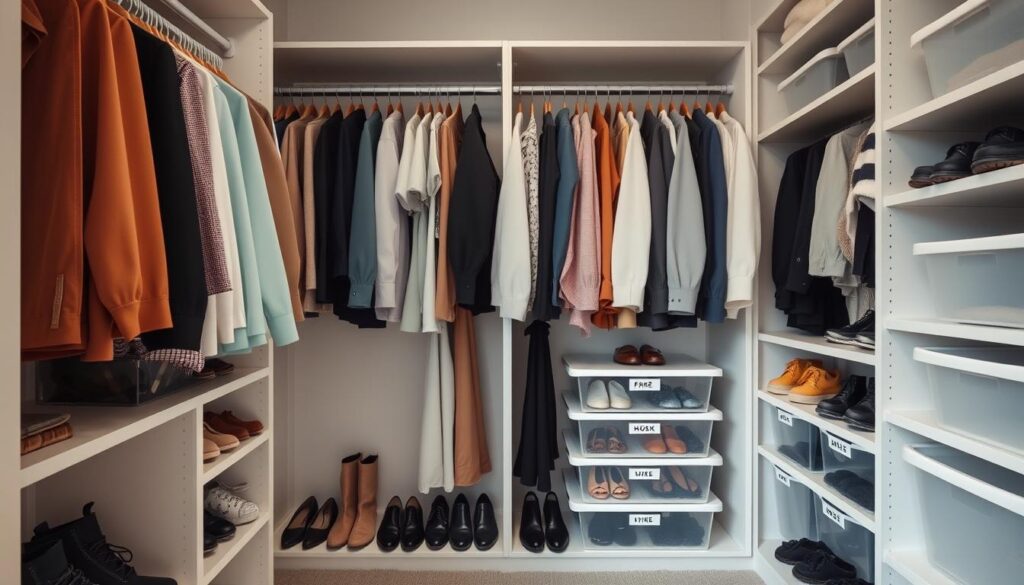
| Action | Benefits |
|---|---|
| Implement the one-year rule | Encourages reflection on style, reduces clutter |
| Conduct a thorough closet clean-out | Minimizes decision fatigue, increases satisfaction |
| Organize by color | Improves visibility, enhances balanced clothing choices |
| Adopt a capsule wardrobe approach | Offers a manageable selection, refreshes wardrobe |
Decluttering the Digital Space
Digital decluttering helps ease the stress from too much clutter. It makes you feel clearer and makes daily tasks easier. Managing emails and organizing files are key steps. Spending a few minutes daily can change how you use technology and boost your mental health.
Managing Your Emails
Email chaos is common, but it can be managed with just 10-15 minutes a day. This helps you spot important messages and ignore distractions. First, unsubscribe from unneeded newsletters. Then, sort your emails into folders for quick access. Use a Digital Declutter Checklist every week for deleting and organizing.
Organizing Digital Files and Photos
Your digital files, like emails, need sorting. Many Americans have countless photos and documents, often unorganized. Set time to organize these files and create folders suited to your needs. Regular check-ups keep your digital space tidy. For fewer distractions, turn off unnecessary notifications. This makes you more productive and less stressed.

| Activity | Time Spent | Frequency |
|---|---|---|
| Email Management | 10-15 minutes daily | Daily |
| Review Digital Declutter Checklist | Varies | Once a week |
| Organizing Digital Files | 2-3 hours (initial organizing) | As needed |
| “Digital Sabbath” | 24 hours | As desired |
By sticking to these habits, you can turn a cluttered digital space into an organized one in five years. This journey is not just about order, but also about a healthier mindset.
Getting Family Buy-In for Decluttering
It can be tough to get everyone on board with decluttering. Showing how it’s done can inspire your family. When you start the decluttering process, your family sees the good in it.
Lead by Example
Show how committed you are to a tidy space. Studies reveal nearly all family members like to help keep a happy home. By showing the positive impact in your space, you encourage them to do the same. Kids who see their parents decluttering are more eager to help clean, increasing their cooperation by 30%.
Creating a Collaborative Environment
Talking about decluttering gets everyone involved. Kids as young as four understand where to donate items. Setting up a “30 Day Challenge” or discarding 100 items over a weekend can make a big difference. This approach builds teamwork and makes everyone feel important. It’s better to focus on making steady progress rather than seeking perfection right away.
Having fewer toys can spark more creativity and better playtime, enhancing play by up to 40%. Respecting each person’s view on clutter can cut down disagreements by 60%. This makes home life smoother. Encouraging your kids to organize their things gives them control. It helps keep their play areas tidy and inviting.

Conclusion
Starting to declutter is not just about tidying up. It’s a step towards personal growth and changing your life. It shows that putting off tasks leads to clutter. This tells us why we must act consistently. Tackling clutter means more than just making space. It means creating a peaceful and clear environment. Think about it – about 80% of our stuff is often unused. That means we likely have more than we need.
The “one in, one out” rule helps keep your home tidy. Experts say setting up routines can reduce clutter by 50%. This shows how important being consistent is. It helps us handle the overwhelming feeling of decluttering. Getting rid of unused items can make you feel accomplished. It also reduces stress for 78% of people who see clutter as a problem.
In the end, cleaning up your spaces helps you value clarity, control, and simplicity. Decluttering should be a continuous practice. This practice is key to emotional and mental health. Every choice about what to keep or give away is a chance for change. It leads to a life in harmony with your values and dreams.
